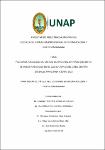Factores asociados al estado nutricional en niños (as) de 6 a 36 meses atendidos en el consultorio del CRED Centro de Salud Panguana II Zona, 2018

View/
Date
2018Author
Aquino Torres, Lenin Gustavo
Isla Rengifo, Cinthia Prissila
Metadata
Show full item recordAbstract
La presente investigación se enmarca en la línea de salud pública y tuvo como objetivo determinar la relación del uso de los multimicronutrientes y hábitos alimentarios con el estado nutricional de los niños atendidos en el consultorio de crecimiento y desarrollo del niño sano (CRED) del centro de salud Panguana II Zona (comunidad rural de la Amazonía peruana). Es una investigación de enfoque cuantitativo de tipo no experimental, diseño descriptivo correlacional; tuvo una muestra de 90 niños cuyas edades fluctuaban entre 6 a 36 meses. Los resultados obtenidos para el indicador Talla/Edad son: 57.80% (52 niños) presentó talla normal para su edad, el 24,40% (22 niños) en riesgo a baja talla, y el 17,80% (16 niños) en baja talla. Los resultados para el indicador hemoglobina son: 60% (55 niños) presentó un nivel de hemoglobina normal, el 30% (26 niños) se encontró con anemia leve, y el 10% (9 niños) tuvo anemia moderada. Los resultados acerca del conocimiento sobre hábitos alimentarios son: 63% (57 madres) presentaron hábitos saludables, a comparación del 37% (33 madres) que presentaron hábitos no saludables. Los resultados sobre el uso de los multimicronutrientes son: 74,40% (67 madres) tienen un nivel adecuado y el 25,60% (23 madres) tuvo un nivel inadecuado. Finalmente, se halló relación estadística significativa entre los hábitos alimentarios y el estado nutricional que presentaron los niños(as) de 6 a 36 meses partícipes del estudio. The current investigation is part of the line of Public Health and was aimed to determine the relationship of the use of multimicronutrients and food habits with the nutritional state of children cared at the doctor’s office of the healthy child’s growth and development at Panguana II zone health center (Local Community of the Peruvian Amazon).
It is a quantitative approach investigation, no-experimental type, descriptive and no correlational design. It had a sample of 90 children who were between 6 to 36 months old. The results obtained for the height/age indicator are: 57, 80% (52 children) got normal size according to their age. 24, 40% (22 children) with risk of short height and 17, 80% (16 children) had short height. The results for hemoglobin indicator are: 60% (55 children) had a normal hemoglobin level, 30% (26 children) were found with mild anemia, and 10% (9 children) had moderate anemia. The results about food habits knowledge are: 63% (57 mothers) presented healthy habits whereas 37% (33 mothers) presented unhealthy habits. The results about the use of the multimicronutrients are: 74,40% (67 mothers) have an adequate level and 25,60% (23 mothers) had an inadequate level. Finally, it was found a meaningful statistical relationship between the food habits and the nutritional state that the children between 6 to 36 months old presented and took part in this study.
Collections
- Tesis [189]
The following license files are associated with this item:

